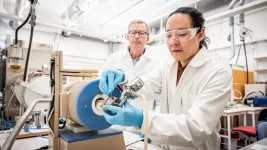(Press-News.org) New research from the University of Pittsburgh explains why metastatic uveal melanoma is resistant to conventional immunotherapies and how adoptive therapy, which involves growing a patient’s T cells outside the body before reinfusing them, can successfully treat this rare and aggressive cancer.
In a paper published today in Nature Communications, the Pitt researchers also explain how they developed a new clinical tool that predicts which patients will respond to adoptive therapy. The work, supported by UPMC Enterprises, is helping improve personalized therapies and avoid futile treatments for metastatic uveal melanoma.
“The dogma was that uveal melanoma is a ‘cold’ cancer, meaning that T cells can’t get into these tumors,” said senior author Udai Kammula, M.D., associate professor of surgery at Pitt and director of the Solid Tumor Cell Therapy Program at UPMC Hillman Cancer Center. “We show that T cells are in fact infiltrating metastases and they’re getting activated, but they’re just sitting there in a dormant state because something in the tumor is suppressing them. Adoptive therapy allows us to rescue these cells from the suppressive tumor microenvironment and successfully treat some patients.”
Uveal melanoma originates in the uveal tract of the eye but has a tendency to aggressively spread throughout the body, often to the liver. When metastasis occurs, this cancer is very difficult to treat and the prognosis for patients is almost always grim.
“Cutaneous melanoma, which affects the skin, is the poster child of immunotherapy. It responds incredibly well to immune checkpoint inhibitor drugs,” said Kammula. “None of these conventional immunotherapies work for uveal melanoma, but we hadn’t known why — until now.”
In a previous Lancet Oncology study, Kammula and his team used adoptive therapy to surgically extract metastatic tumors from 19 uveal melanoma patients and grow T cells from these tumors in the laboratory. When they infused the cells back, 35% of patients had either partial or complete regression of their cancer, evidence against the assumption that cancer-fighting cells called tumor-infiltrating lymphocytes (TILs) aren’t found in uveal melanoma. But it was still a mystery why immune checkpoint inhibitors, which rev up the activity of these T cells, are ineffective in treating this disease.
Kammula saw an opportunity to answer this question using a unique resource that he and his team have been building for the last decade: the largest known repository of uveal melanoma samples, corresponding tissues and clinical information.
When the researchers analyzed 100 metastases from 84 patients, they found that over half of these tumors were chock-full of T cells. Next, they performed single cell RNA sequencing to measure gene expression in almost 100,000 cells from six metastases. They found that the TILs in some of these tumors were activated and capable of attacking tumor cells in a dish, but they weren’t proliferating to high numbers in the tumor.
“We found that TILs from metastatic uveal melanoma have the potential to attack the tumor, but something in the tumor microenvironment is shutting them down, so they’re in a dormant, or quiescent, state,” explained Kammula. “By liberating these cells from the suppressive environment and growing them in the lab, we can rescue their tumor-fighting capacity when infused back into the patient.”
But TIL therapy doesn’t work for everyone, as the researchers found in their earlier study. To predict which patients will respond and which will not, Kammula and lead author Shravan Leonard-Murali, M.D., a post-doctoral fellow in the lab, developed a clinical tool called Uveal Melanoma Immunogenic Score (UMIS), a holistic measure of the tumor that reflects the activity of more than 2,000 genes expressed by tumor cells, immune cells and other cells that form the tumor microenvironment. UMIS ranged from 0.114 to 0.347 across 100 metastases, with higher values indicating tumors with more potent TILs.
When the researchers looked at patients who received adoptive therapy in the earlier study, they found that patients with higher UMIS scores had better tumor regression, suggesting that this biomarker could predict which patients are likely to respond.
They also found that patients with metastases scoring above 0.246 had significantly improved progression-free survival and overall survival than those with UMIS below this cutoff.
“If a patient’s UMIS level is below this threshold, we think that adoptive therapy is not appropriate. Using a biopsy to calculate a patient’s UMIS could help avoid futile therapies and unnecessarily subjecting patients to invasive operations,” said Kammula. “But the immune system is not static. UMIS offers a window into the tumor that could also help us find the optimal time to treat a patient with adoptive therapy, like picking a fruit when it’s at its ripest.”
Kammula is now evaluating the score prospectively in an ongoing TIL therapy clinical trial at Pitt for patients with metastatic uveal melanoma.
He and his team are also taking what they’ve learned from uveal melanoma to tackle other difficult-to-treat tumors such as pancreatic cancer, and they are developing a pan-cancer version of UMIS that will predict how well a patient with any type of cancer is likely to respond to adoptive therapy.
Additional authors on this research are Chetana Bhaskarla, Ph.D., Ghanshyam S. Yadav, Ph.D., Sudeep K. Maurya, Ph.D., Chenna R. Galivet, Ph.D., Joshua A. Tobin, Rachel J. Kann, Eishan Ashwat, Patrick S. Murphy, Ph.D., Anish B. Chakka, Ph.D., Vishal Soman, Paul G. Cantalupo, Ph.D., Xinming Zhuo, Ph.D., Gopi Vyas, M.S., Dara L. Kozak, Lindsey M. Kelly, Ph.D., Ed Smith, M.S., M.B.A., Uma R. Chandran, Ph.D., Yen-Michael S. Hsu, M.D., Ph.D., all of UPMC Hillman, Pitt or both.
In addition to support from UPMC Enterprises, the innovation, commercialization and venture capital arm of UPMC, this work was supported in part by the Pitt Center for Research Computing, the National Institutes of Health (S10OD028483), the UPMC Hillman Cancer Center Immunologic Monitoring and Cellular Products Laboratory (CCSG P30 CA047904), and a National Cancer Institute training grant (T32CA113263).
END
New insights could unlock immunotherapy for rare, deadly eye cancer
2024-04-16
ELSE PRESS RELEASES FROM THIS DATE:
Biodiversity is key to the mental health benefits of nature, new study finds
2024-04-16
New research from King’s College London has found that spaces with a diverse range of natural features are associated with stronger improvements in our mental wellbeing compared to spaces with less natural diversity.
Published in Scientific Reports and funded by the National Institute for Health and Care Research (NIHR) and Wellcome, this citizen science study used the smartphone application Urban Mind to collect real-time reports on mental wellbeing and natural diversity from nearly 2000 participants.
Researchers found that environments with ...
A single atom layer of gold – LiU researchers create goldene
2024-04-16
For the first time, scientists have managed to create sheets of gold only a single atom layer thick. The material has been termed goldene. According to researchers from Linköping University, Sweden, this has given the gold new properties that can make it suitable for use in applications such as carbon dioxide conversion, hydrogen production, and production of value-added chemicals. Their findings are published in the journal Nature Synthesis.
Scientists have long tried to make single-atom-thick sheets of gold but failed because the metal’s tendency to lump together. But ...
Most countries struggle to meet climate pledges from 2009
2024-04-16
Nineteen out of 34 countries surveyed failed to fully meet their 2020 climate commitments set 15 years ago in Copenhagen, according to a new study led by UCL researchers.
The study, published in Nature Climate Change, compared the actual net carbon emissions of more than 30 nations to their 2009 pledged emission reduction targets set during the Copenhagen Climate Summit.
The paper led by researchers at UCL and Tsinghua University is the first effort to comprehensively gauge how well countries were able to meet their Nationally Determined Contribution reduction pledges from COP15.
Of the 34 nations analysed in the study, ...
Photonic computation with sound waves
2024-04-16
Optical neural networks may provide the high-speed and large-capacity solution necessary to tackle challenging computing tasks. However, tapping their full potential will require further advances. One challenge is the reconfigurability of optical neural networks. A research team in the Stiller Research Group at the Max Planck Institute for the Science of Light, in collaboration with the Englund Research Group at the Massachusetts Institute of Technology, has now succeeded in laying the foundation for new reconfigurable neuromorphic building blocks by adding a new dimension to photonic machine learning: sound waves. The researchers use light to create ...
New study focuses on the placenta for clues to the development of gestational diabetes
2024-04-16
BOSTON, MA – A new study led by the Harvard Pilgrim Health Care Institute has identified that a deficit in the placental expression of the gene insulin-like growth factor 1 (IGFBP1) and low IGFBP1 circulating levels are associated with insulin resistance during pregnancy, highlighting a potential risk factor for the development of gestational diabetes.
The study, “Placental IGFBP1 levels during early pregnancy and the risk of insulin resistance and gestational diabetes,” appears in the April 16, 2024 edition of Nature Medicine.
Gestational diabetes, a disease that can lead to multiple pregnancy and delivery complications, is the most common pregnancy ...
Care home staff and residents need ‘family’ bonds to thrive
2024-04-16
University of Leeds news
Embargo: Tuesday 16 April, 2024, 10am UK time
Care home staff and residents need ‘family’ bonds to thrive
Care home residents receive much better care when they enjoy ‘family’ bonds with staff – but staff must be empowered to create these bonds, new research has found.
The study, led by the University of Leeds and funded by The National Institute for Health and Care Research, found that when care home staffing is stable and consistent and numbers are sufficient, workers have the capacity to develop ‘familial’ ...
New Inflammatory Bowel Disease testing protocol could speed up diagnosis
2024-04-16
Patients with suspected inflammatory bowel disease (IBD) could benefit from better testing protocols that would reduce the need and lengthy wait for potentially unnecessary colonoscopies, a new study has found.
In a paper published in Frontline Gastroenterology, researchers from the Birmingham NIHR Biomedical Research Centre (BRC) at the University of Birmingham tested a new protocol to improve IBD diagnosis combining clinical history with multiple home stool tests.
In the two-year study involving 767 participants, patients were triaged and had repeated faecal calprotectin (FCP) tests and the research team found that the use of serial FCP tests were able to strongly predict possible ...
Most massive stellar black hole in our galaxy found
2024-04-16
Astronomers have identified the most massive stellar black hole yet discovered in the Milky Way galaxy. This black hole was spotted in data from the European Space Agency’s Gaia mission because it imposes an odd ‘wobbling’ motion on the companion star orbiting it. Data from the European Southern Observatory’s Very Large Telescope (ESO’s VLT) and other ground-based observatories were used to verify the mass of the black hole, putting it at an impressive 33 times that of the Sun.
Stellar black holes are formed from the collapse of massive stars and the ones ...
New review offers first recommendations on accurately assessing the carbon footprint of coffee farming
2024-04-16
Tuesday 16 April: A new scientific review1 published in Sustainable Production and Consumption explores how best to standardize measurement of the environmental impact of coffee – a commodity increasingly threatened by climate change2.
Measurement of green coffee’s carbon footprint has traditionally varied, as is often the case for any agricultural lifecycle assessment. The Institute for Scientific Information on Coffee (ISIC) commissioned the French Agricultural Research Centre for International Development (CIRAD) to review current methodologies for green coffee, revealing a more precise picture of how to measure the environmental impact of the ...
Seed ferns: Plants experimented with complex leaf vein networks 201 million years ago
2024-04-16
According to a research team led by palaeontologists from the University of Vienna, the net-like leaf veining typical for today’s flowering plants developed much earlier than previously thought, but died out again several times. Using new methods, the fossilised plant Furcula granulifer was identified as such an early forerunner. The leaves of this seed fern species already exhibited the net-like veining in the late Triassic (around 201 million years ago). The study was recently published in the journal New Phytologist.
Mario Coiro and Leyla Seyfullah of the Department of Palaeontology at the University of ...






